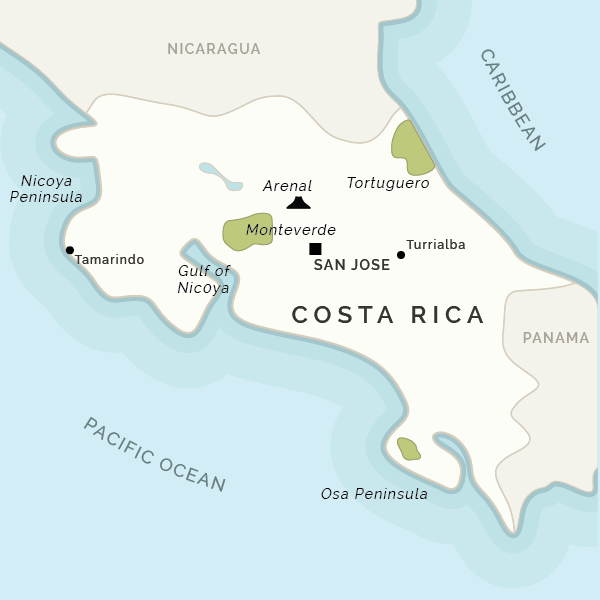A perfect place to begin your Costa Rican Vacation. Tortuguero is a heavily protected and very important conservation park located on the Caribbean coast in the north eastern part of the country, named after the turtles that annually arrive on the 22 miles of sands to lay their eggs.
South America Safari experiences don't get much better than Tortuguero - also ideal for a Costa Rica family holiday. In this watery world of extraordinary biodiversity, Howler monkeys act as Mother Nature’s natural alarm clock and basilisk lizards, (otherwise known as Jesus Christ lizards) demonstrate that walking on water is possible. Among other natural phenomena, witnessing the jurassic turtles laying their eggs on the beaches of Tortuguero is utterly mesmerizing.
Tortuguero is a nature lover's dream. You explore the waterways and forests in search of poison dart frogs, basilisk lizards and share your cabana roof with noisy monkeys!
Expeditions to the National Park are usually run in small groups. Tortuguero is only accessible by boat or small plane . You will have a guide that looks after you for the duration of your time exploring the local area, but the remoteness of the lodges means that there are no options to go out of the lodge to dine, so all meals are included and are usually buffet style.
The main attractions would have to be goggling at the amazing nesting turtles - a truly unforgettable experience. Bird is popular and there are a huge number of species and you will be blown away by the variety. In order to see all of this fantastic flora and fauna, access through the park via boat rides is a popular choice and lets you get up close to the spectacular wildlife.
For a more luxurious stay, we recommend one of the smaller and more remote lodges in places such as Manatus where your experience will be superior and more intimate. However, if you want to be fully immersed in the nature of the park and aren't fussed about luxury, our favourite lodge is Mawamba - with fantastic guides in a great location it is ideal for getting the most out of the park.
This is a glorious place, thriving with natural wonders, but also with visitors. Be prepared for the busy route to your lodge and for sharing this national park with large groups.
The drier season runs from December to March. However, the turtle lay their eggs from July to October and it is worth putting up with the wetter conditions to witness this.
Tortuguero - Things to do
Tortuguero is a nature lover's dream. You explore the waterways and forests in search of poison dart frogs, basilisk lizards and share your cabana roof with noisy monkeys!
Expeditions to the National Park are usually run in small groups. Tortuguero is only accessible by boat or small plane . You will have a guide that looks after you for the duration of your time exploring the local area, but the remoteness of the lodges means that there are no options to go out of the lodge to dine, so all meals are included and are usually buffet style.
The main attractions would have to be goggling at the amazing nesting turtles - a truly unforgettable experience. Bird is popular and there are a huge number of species and you will be blown away by the variety. In order to see all of this fantastic flora and fauna, access through the park via boat rides is a popular choice and lets you get up close to the spectacular wildlife.
Tortuguero - Where to stay
For a more luxurious stay, we recommend one of the smaller and more remote lodges in places such as Manatus where your experience will be superior and more intimate. However, if you want to be fully immersed in the nature of the park and aren't fussed about luxury, our favourite lodge is Mawamba - with fantastic guides in a great location it is ideal for getting the most out of the park.
Tortuguero - Our opinion
This is a glorious place, thriving with natural wonders, but also with visitors. Be prepared for the busy route to your lodge and for sharing this national park with large groups.
Tortuguero - Top tips
The drier season runs from December to March. However, the turtle lay their eggs from July to October and it is worth putting up with the wetter conditions to witness this.


